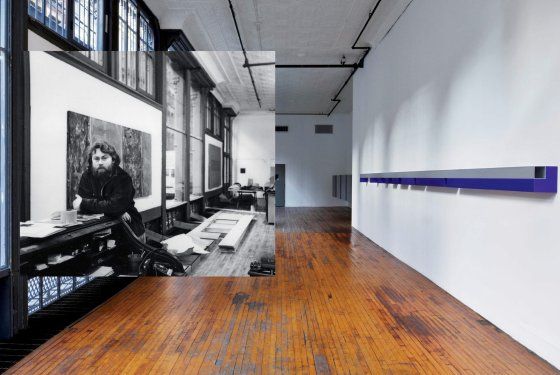In 1968, Donald Judd — the artist known for his boxy, implacable sculptures and wall pieces — paid $68,000 for 101 Spring Street, a graceful but dilapidated five-story cast-iron building, and began his renovation by hauling out truckloads of trash. Over the years, he kept installing art and modifying the architecture in pursuit of an ideal balance. After his death in 1994, the building sat, stilled. Starting on June 3, after a three-year, $23 million restoration, the Judd Foundation will open 101 Spring to the public for guided tours in groups of eight by reservation. Art critic Jerry Saltz and architecture critic Justin Davidson walked through it together.
Justin Davidson: This house feels like the total work of art. We get to see how Judd slept in a Judd bed, ate at a Judd table, washed his hands in a Judd sink, and enjoyed the art he and his friends made. You can’t wander on your own, but the trade-off is that you don’t have to peer at a room from behind a rope. So what do you think, Jerry — is this a platonic ideal of how his life and work should be experienced?
Jerry Saltz: Judd had no use for disembodied platonic ideals. He’s totally anti-mystical, very American. For him, space is a living substance, not an empty chamber that God and ideas inhabit. I’ve been in a million lofts, and this one has the most palpable, even sensual feeling I’ve ever encountered. When I’m inside the space, I’m part of it; it’s part of me. It’s trippy and physical.
J.D.: I love the space, too, but I guess I’m thinking a bit more concretely. On a beautiful spring day, the light coming in those enormous windows with the rippled glass makes the art glow. That effect doesn’t come easily or cheaply: Architecture Research Office, the firm that oversaw the renovation, made a lot of great invisible decisions. They had to perform all kinds of contortions to meet fire code without just closing off a stair or slapping big old sprinklers on the ceilings. As with all minimalist architecture, achieving simplicity means hiding a lot of mess.
J.S.: Ugh — Judd loathed the word minimalism.
J.D.: But it’s a legitimate description of his style, isn’t it?
J.S.: It’s more of a shorthand label for his whole philosophy. In the early sixties, a number of artists were working in that vein, but Judd applied those ideas to sculpture, painting, furniture, and architecture. He coined the term specific object to describe his work and that of friends like Dan Flavin and John Chamberlain. It meant that when you looked at a fluorescent-light piece by Flavin that it was no longer a fixture, or hardware, or a familiar idea of sculpture. Boom! It’s a specific object. To me 101 Spring Street has become a specific object — a great one.
J.D.: It looks really handmade to me, which is sort of surprising. Judd often had others fabricate his work, but the house feels like he took out a hammer and banged everything together himself. And the result is almost a movie set. It tells a story. Look at the floors: The wavy boards on the ground level are gouged, patched, and stained, but the fourth floor is all freshly shined planks. Those floorboards narrate the transformation of a factory into the giant garbage can it was when Judd bought it, then into his home and laboratory, and now into a ravishing diorama.
J.S.: Judd would yell at you for thinking that. Calling it a diorama implies being on the outside, looking in at something fabricated and artificial. Of course, I’m told he’d yell at pretty much anyone for anything.
J.D.: Don’t you think there’s some irony here, though? Judd hated museums, so he created this place as a living antidote. But now it’s become — dare I say it? — a house museum. How could it be anything else?
J.S.: Well, if you just go for the museum part, there are A1 masterpieces of art here by Flavin, Chamberlain, Stella, Oldenburg, Andre. In Advance of the Broken Arm, my favorite Duchamp ready-made, is here, and it’s my fave because it’s the least aesthetic of all. Could the architects have done something to make it more alive for you?
J.D.: I think they got the restoration just right, mostly by being obsessive about authentic detail. Judd finished a wall with cheapo, rough commercial plaster, and you can’t get that stuff anymore — it’s all much silkier now — so to get the same sloppy effect, they had to do research and mix a custom batch. Hardly anybody would notice that, but it contributes to the texture of the experience. Of course, it would look even more authentic if they blew soot all over it.
J.S.: I love that it’s been restored this way. It’s an important step in righting the Judd ship — a toehold in New York. Right now, people are able to see most of Judd’s ideas in Marfa [the small Texas town that he turned into a contemporary-art center], but not here. He’s a genuine American genius on the level of Frank Lloyd Wright and Emerson, and some of that genius is this building. It’s not a “how the great man lived” mausoleum or reliquary. It embodies how he thought about and understood environment; redefined what usage is; and explored different vocabularies of the nonlinear, nonverbal logic of experiencing space. The building and its rooms are a map for the future to decipher, an atlas of ways to plumb space.
J.D.: And he did all that in a building that already existed!
J.S.: You know, that makes me wonder: What do architects make of him today?
J.D.: I think they’ve internalized many of his ideas about reclaiming old materials and opening up spaces without acknowledging where they came from. It’s amazing how many of Judd’s experiments later turned into clichés of industrial chic: the tension between vast rooms and little nooks, the sleeping lofts, the steel sink, the pine-board shelves. It was an idiosyncratic DIY design approach that’s since been totally commercialized.
J.S. He changed the way the world looked, and the way we look at the world. I revere him.
*This article originally appeared in the May 27, 2013 issue of New York Magazine.





